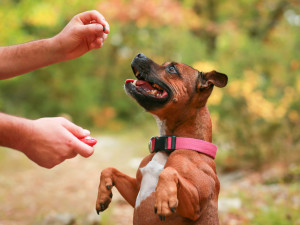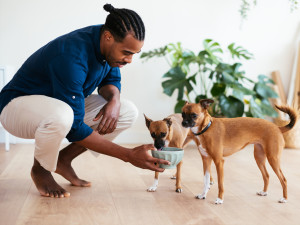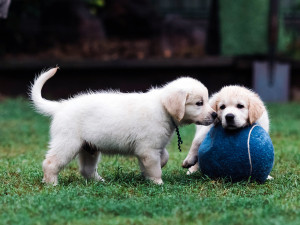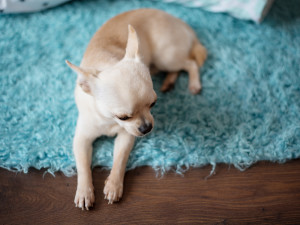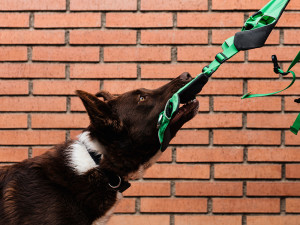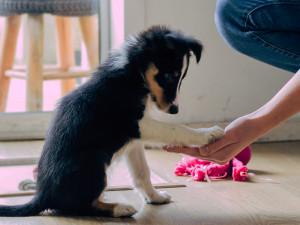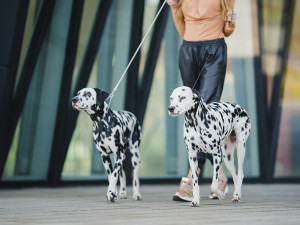How to Use Dog Treats for Training
Here’s your guide to how treats can help as your new pup is learning all the things.
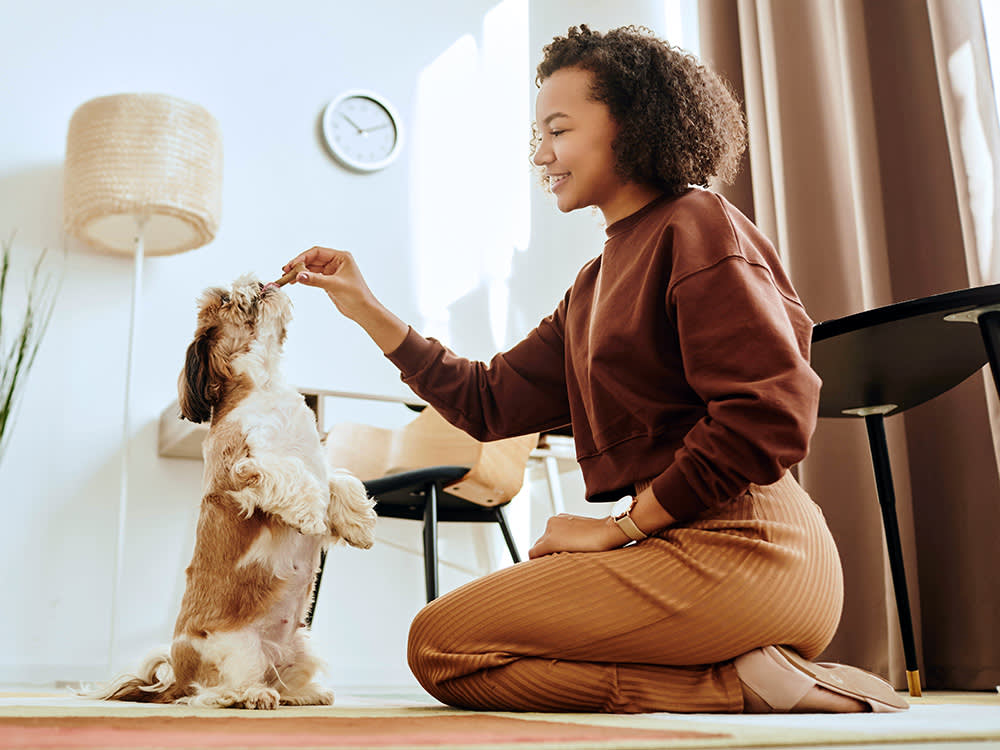
Share Article
In this Article:
Why Use Training Treatsopens in a new tab How to Use Training Treats opens in a new tab How to Choose the Right Treat opens in a new tab Common Mistakes When Training With Treatsopens in a new tab
Welcoming a new dog into your life is an exciting time, whether you’re a brand-new pet parent or an experienced one. Either way, there will be plenty of decisions to make, supplies to stock up on, and questions to ask, like: How will you train your new friend, and what will you need to have on hand for training sessions?
The TL;DR answer is to give your dog treats when they do what you want them to do. But of course, there’s a lot more to it than that. Here’s how, why, and what kinds of treats to use to train your dog — plus, the biggest mistake most people make when using dog treats for training.

littleKin™ is Kinship’s home just for puppy and kitten parents. Bop over to check out expert advice, new pet tools, and special deals—all curated for your newest family member.
opens in a new tabWhy you should use treats during training
“Should I use treats to train my dog?”
It’s a question many new pet parents ponder — especially if they’re concerned about creating a situation where their dog becomes, well, a treat houndopens in a new tab. After all, you want your dog to behave even when you don’t have something yummy in your pocket to entice them. But while wanting your dog to follow commands without resorting to bribery (or getting them hooked on treats) is understandable, using treats to train dogs is a tried-and-true method for good reason: it works.
“Positive reinforcement has been shown to be the most effective way to train a dog,” says Sean Prichard, a certified canine fitness coach (CCFC) and president at Pant & Wagopens in a new tab. And what does positive reinforcement look like when it comes to dogs? “Positive reinforcement training simply means the dog gets a reward for a desired behavior,” Prichard says. “For food-motivated dogs, the easiest and best reward is usually a treat.”
Research backs this up: A March 2023 study found that although you can use social interaction to train your pup, food is far more effective (for the most part — because just like humans, all dogs are differentopens in a new tab).
The bottom line? Using dog treats for training can be great incentive for your dog. Make sure to select a small, flavorful treat your dog loves. The treats will act as positive reinforcementopens in a new tab when your dog exhibits the desired behavior you are training for. To correctly use the treats, immediately reward your dog and offer verbal praise. Stay consistent to reinforce the behavior. Gradually, you can replace the high-value treats with other positive reinforcement, such as praise or play.
Keep reading to find out more about how to use treats for dog training, what to use as training treats for dogs, the best training treats for dogs, and even how to make your own dog treats for training (did someone say DIY?).
How to use treats during training sessions
The first, and perhaps most important, step in training your pup is to approach the situation with humor, positivity, and a big dose of patience.
A study published in the July 2011 issue of Applied Animal Behaviour Scienceopens in a new tab found that dogs whose parents were playful and patient did better at learning new tasks, and a 2004 studyopens in a new tab published by Cambridge University Press highlighted the effectiveness of rewards versus punishment when teaching dogs to do a variety of things including sit on command, heel, drop an object, come when called, and stop stealing food.
“Punishment was associated with an increased incidence of problematic behaviors,” the Cambridge authors wrote, concluding that there was no benefit to yelling or physical discipline and that positive training methods work much better.
You’ll also want to keep the following things in mind when you're treat-training your dog:
1. Use a clicker.
“The best way to use treats is in conjunction with a clicker,” says Lorrie Reynolds, owner of Maximum Fun Dog Sportsopens in a new tab. To teach or practice the behavior you want, follow three simple steps: cue the behavior (this is when you say “heel” or “sit”), mark the behavior with the clicker as soon as your dog does it, then give the treat.
Never used a clicker before? Reynolds suggests a brief training session to get your pup to associate the clicker with the treat. “Click the clicker and give a treat in rapid succession ten or so times, then wait for the dog to get distracted and click the clicker. If the dog turns back, you know the pairing was successful. If not, do another round until the dog understands what the click means.”
2. Use high-value treats.
Can you use dog food as training treats? Think of it this way: Would you do what someone told you just because they offered you a spoonful of your go-to overnight oats as a reward? Probably not — even if you enjoy them at breakfast. Your dog is no different.
“The treats need to be of high value to the dog; the more the dog enjoys the treat, the more likely they will reproduce the desired behavior to get another treat,” Prichard says. So, if you want your pup to get enthusiastic about following commands, skip the everyday fare.
3. Use treats as a reward, not a bribe.
Whats the difference? “Bribery is basically ‘See this? Now do that and you get this,’” says Ali Smith, dog behavior consultant and founder of Rebarkableopens in a new tab. A reward, on the other hand, is given after your dog sits, stays, heels, shakes hands, or whatever you're trying to get them to do. “Positive reinforcement is ‘Do this? Yeah! Well done, have this!’” Smith says.
4. Give treats right away.
No one is saying your dog isn’t smart — brilliantopens in a new tab, even — but when it comes to using treats for training, they may not have the best memory as to what they’re being rewarded for. “It’s important that the treat is given immediately after the desired behavior is achieved; many people wait too long,” Prichard says. “Even waiting a single second can reduce the effectiveness of training.”
5. Don’t skimp on the treats.
When training a new member of your household, Smith is a proponent of giving treats “as often as possible for anything your dog does right, whether that’s cued or naturally performed.” That means you don’t have to be actively conducting a training session in order to toss out a few treats.
“Science has shown us time after time that positive reinforcement is the most effective and least risky way to train,” Smith says. So, go ahead and dole out those treats whenever you see behavior you want to encourage. (Carrying a treat pouch for dog trainingopens in a new tab helps ensure you’ll always have some on hand.)
6. But do gradually reduce the frequency of treats.
All good things must come to an end, and that includes getting rewarded for every single “sit,” “stay,” “heel,” and “leave itopens in a new tab!” That doesn’t mean you’ll never give your dog treats once they learn the ropes — it just means that after a while, you can leave that dog treat pouch at home when you head out for a stroll with your best friend.
“If treats are overused, a dog may become reliant on them for obedience,” Prichard says. “Gradually reduce treat frequency as the behavior becomes ingrained.”
How to choose the right training treat for your dog
In order for treat-training to work, your dog needs to really want that treat — so it’s got to be good. But you also want the treat to be good for them. “I could probably train my dog to do my taxes using ice cream and hot dogs as incentives, but it wouldn’t be worth the harm it would cause to her,” Prichard says. “Dog parents and trainers need to find a balance between high-value treats, while also being conscious of the dog’s health. Many treats are void of nutrition and loaded with calories and sugar which is detrimental to a dog’s fitness level.”
Smith likes to use liver, cheese, dried chicken hearts, and other meats or meat byproducts, and points out that the treats only need to be pea-sized. Reynolds concurs: “Higher-quality treats are more expensive, but dogs don’t care how big the treats are. You can successfully train with treats cut into pea-sized pieces, so one bag of treatsopens in a new tab goes a long way.”
Common mistakes when using training treats
If you follow the above steps and guidelines, you’ll likely have success with training your dog using treats. Prichard and Reynolds called out a few of the most common mistakes people make:
Luring your dog with treats
“Luring to initially teach a behavior is fine, but once the dog understands what the owner wants, the treat should not come out before the behavior occurs,” Reynolds says. “If a dog will only perform a behavior if the food is present, treats have been used as bribes instead of rewards.”
Prichard agrees, adding: “Avoid using treats to lure your dog into a behavior. The reward should come after the desired action, not before.”
Rewarding the wrong behavior
“If the handler asks for a ‘sit’ but then presents the treat where the dog has to get up to get it, they have rewarded getting up, not sitting,” Reynolds says. Giving the treat the instant your dog performs the desired behavior is crucial for this reason. (And if you find yourself getting nipped when your dog excitedly chomps their reward, here are some tips on teaching your dog to take treats gentlyopens in a new tab.)
Making treats too big
On a practical level, Prichard points out that keeping treats pea-sized is easier for both you and your pup. Not only will you be able to hold more in your hand, your dog will gobble them up quickly “so they don’t spend the entire training session chewing.”
Giving too many training treats
You want to watch how many treats you give for a couple of reasons. First is your dog’s health: “Treats contribute to your dog’s daily caloric intake. Ignoring portion control can lead to overfeeding and potential health issues,” Prichard says.
Worried you’re being too stingy with the treats? Reynolds says to put that thought out of your head. “A single treat or a handful of treats presented all at once are the same to a dog.” If your dog has mastered something they’ve struggled with, however, it’s OK to reward them a little extra. “Multiple treats given one at a time make a bigger impact when the dog has done something especially well,” Reynolds says.
FAQs (People also ask):
Can you train a dog without treats?
While dog trainers say treats are the easiest and most effective way to teach behavior, they’re not the only thing your pup will respond to. “Treats should be just one tool in your training toolbox,” Prichard says. “A well-rounded training approach includes a mix of positive reinforcement including treats and verbal praise, exercise, and socialization.”
Are there alternatives to store-bought training treats?
Want to make your own training treats? It’s easy — just chop your dog’s favorite treat (cheese, liver) into pea-sized bites, and you’re in business. In fact, your dog may prefer your homemade treats to store-bought ones. “[Many people believe] dogs prefer highly processed treats; usually that’s not the case,” Smith says.
If you want to get a little fancier in the kitchen, there are plenty of recipes you can whip upopens in a new tab that are sure to make your dog droolopens in a new tab. Now, the only thing you need to worry about is keeping your friends and family from spoiling all you and your pup’s hard work (possibly by sneaking them too many treats on the side). Here’s how to handle thatopens in a new tab if it happens.
References:

Elizabeth Laura Nelson
Elizabeth Laura Nelson is a writer and editor based in Brooklyn, New York. As a child, Elizabeth was scared of cats (claws and teeth, yikes) but she has since gotten over her fear and now shares her home with three sweet and gentle feline companions who make life better (and cuddlier) every day.
Related articles
![Tan Chihuahua dog laying on aqua rug looking down shamefully]() opens in a new tab
opens in a new tab“Why Is My Adult Dog Peeing In The House?”
How to re-housetrain a dog of any age.
![girl with blue hair starting puppy training with white dog]() opens in a new tab
opens in a new tabPuppy Training 101: How to Train a Puppy
You gotta start somewhere.
![Dog is biting his dog harness to take the dog for a walk]() opens in a new tab
opens in a new tabNobody Likes to Be Labeled — Especially Your Dog
(Mis)labeling behaviors does more harm than good.
![Border Collie puppy shaking owner's hand]() opens in a new tab
opens in a new tabWhen to Start Training a Puppy: a Complete Puppy Training Schedule By Age
Your puppy training schedule, from eight weeks to six months. Let’s do this.
![Afghan hound dog mid jump in an open grass field]() opens in a new tab
opens in a new tabOverexcited Dog? How to Calm A Dog Down
If your dog loses their sh*t over anything—from a squirrel to a guest. Here are some tips to curtail that.
![Owner walking two Dalmatians downtown]() opens in a new tab
opens in a new tabHow to Stop a Dog From Pulling on the Leash
Dog trainer Karen B. London promises you’re not doomed to be pulled down the street forever.


